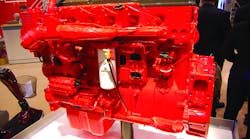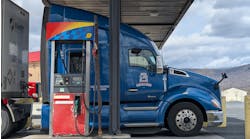Touted by the Obama Administration as a win-win-win for the environment, trucking industry and consumers, the proposed second round of fuel economy standards for medium- and heavy-duty vehicles are meant to reduce climate change impact while bolstering energy security and spurring manufacturing innovation.
But nearly a year after being jointly published by the U.S. Environmental Protection Agency (EPA) and the Dept. of Transportation’s National Highway Traffic Safety Administration (NHTSA), the honeymoon between the government and the industry—if there ever was one—is certainly over.
The greenhouse gas (GHG) final rule is still up in the air, and no one is quite sure what to expect from it when it is published. Broadly, the proposed rule pits the trucking industry, which wants a cautious, doable program, against clean air groups that insist on the most aggressive of the proposal’s goals and timelines. Even within trucking, factions have developed: Engine maker Cummins supports a separate engine-only standard, and trailer makers argue that EPA has no authority under the Clean Air Act to regulate them at all.
There’s also more than a little concern that any “technology-forcing” goals could result in performance and reliability issues similar to the implementation of EPA’s NOx regulations a decade ago—and that new, more strict NOx restrictions will be included in the GHG final rule, or follow shortly thereafter, with contradictory goals.
As for the timing, the rule is slated to be finalized this summer, but there is no statutory deadline.
Here’s a general outline of where the proposal stands and the cases for or against the various elements in the complex and far-reaching plan.
THE BASICS
The proposed standards—dubbed Phase 2 as a follow-up to the original truck fuel economy standards that set targets for 2014 and 2017 model-year trucks—are expected to lower CO2 emissions by about 1 billion metric tons, cut fuel costs by about $170 billion, and reduce oil consumption by up to 1.8 billion barrels over the lifetime of the vehicles sold under the program.
Medium- and heavy-duty vehicles account for about 20% of GHG emissions and oil use in the U.S. transportation sector but only comprise about 5% of vehicles on the road, according to the federal government.
The proposed vehicle and engine performance standards would cover model years 2021-2027 and apply to semi-trucks, large pickup trucks and vans, and all types and sizes of buses and work trucks. They would achieve up to 24% lower CO2 emissions and fuel consumption than an equivalent tractor in 2018, based on the fully phased-in standards for the tractor alone in a tractor-trailer combination.
Unlike the automobile fuel economy standards, Phase 2 does not use an mpg measure. EPA considers such a measurement meaningless for the many trucks and applications covered under the proposal.
For highway tractors, the key is freight efficiency, or the amount of freight that can be hauled per mile, per gallon of fuel. In 2027, EPA estimates the average line-haul truck would achieve a 50% improvement with that potentially rising to 90% with the development and adoption of more efficient technologies.
Experts at the Environmental Defense Fund did the hypothetical math and put the 2027 goal at about 9.5 mpg for highway tractor-trailers compared to about 6 mpg in 2010.
In this next phase, EPA and NHTSA are also proposing efficiency and GHG standards for trailers for the first time. The EPA trailer standards would begin to take effect in model-year 2018 for certain trailers, while NHTSA’s standards would be in effect as of 2021. Credits would be available for voluntary participation before then.
DOABLE, OEMS SAY, BUT…
The goals for the federal truck fuel efficiency requirements will be achievable, says the head of the country’s largest truck maker—he’s just not sure yet what the solutions are going to be. And all bets are off if EPA’s Phase 2 GHG reduction program strays from the preliminary standards proposed, Daimler Trucks North America (DTNA) President and CEO Martin Daum told trucking media representatives last fall.
That proposed target of a 24% improvement in heavy-duty fuel efficiency by 2027 is “a lot,” he concedes.
While DTNA is generally supportive of the program’s goals, Daum objects to the possible engine-only standard on top of the whole-vehicle requirements.
“I’ve never seen an engine alone running down the road,” he quips. “We need all the pieces to fit together to optimize [fuel efficiency]. But the higher the engine standard, the less room we have for optimization.”
DTNA would like to see a single national standard, but the real concern is for the possible development of a new NOx limit. Daum worries that the GHG rule will be finalized and manufacturers will begin to work toward meeting the requirements, and then EPA will set another NOx standard causing an industry disruption similar to 2006.
More formally, DTNA joined with Caterpillar, Navistar, Paccar, and Volvo Group in filing comments on the proposed rule. To assure that the rule benefits customers—and achieves environmental goals—the Phase 2 regulation must be finalized with seven basic principles in mind, the truck makers note:
- Regulation must appropriately reflect real-world reductions.
- There must be a single, national GHG regulation adopted by EPA, NHTSA and CARB.
- Expected technologies must be appropriately demonstrated.
- Expected technology penetration rates must align with market needs and legal restrictions.
- Regulation must take into account total cost of ownership.
- Protocols must be clearly defined and accommodate production and test variability.
- Regulation must recognize the trade-off of NOx and CO2 reduction targets.
FLEETS WANT ROI
Indeed, while the final rule is aimed at truck makers, truck buyers clearly have a stake. After all, if customers won’t buy the trucks, the environmental goals won’t be achieved, the American Trucking Assns. (ATA) notes in its formal comment.
“The consistent message from fleets to ATA regarding the Phase 2 rule is abundantly clear: Achieve the greatest efficiency improvements at the least overall cost while minimizing downtime, maximizing durability, and recognizing a positive return on investment over the course of equipment ownership,” ATA says.
Among ATA’s key points:
- ATA opposes the accelerated timeline option that pulls ahead the 2027 targets to 2024. “If Phase 2 results in customers being led down a path to purchase technologies that are not proven, cost-effective, or reasonable for a fleet’s applications, fleets will keep their vehicles and trailers longer and will pre-buy in advance of the changes, followed by a subsequent no-buy after the new standards take effect.”
- Technology costs remain suspect. “ATA believes the agencies underestimated the costs of various technologies, making the payback period on these technologies much longer than is stated in the proposed rule.”
- Need for harmonization between state and federal GHG/fuel economy programs. “ATA supports these efforts as harmonization with California (or other states for that matter) is an extremely high priority. It is both unwise and unhealthy for the nation’s economy and the movement of the nation’s freight to allow a patchwork of state and federal tailpipe and fuel consumption standards for trucks to emerge.”
- Further evaluation and demonstration is needed before committing to a low-NOx engine standard. “Given EPA expects fleets to pay an additional $14,000 for a new tractor-trailer combination meeting the Phase 2 standards, the agencies must be sensitive to the cost impact additional regulatory pursuits will have on the trucking industry.”
TRAILER AUTHORITY
The trailer industry has questioned EPA’s right to even set trailer targets. “Unfortunately, by extending its proposed rule to semi-trailers, the EPA has adopted an unprecedented interpretation of its authority that exceeds its Congressional authorization,” Utility Trailer Manufacturing, the nation’s largest trailer builder, wrote in its filing. “Additionally, the agencies have based their analysis on assumptions that are completely untethered from the real world, resulting in proposed regulations that will yield minimal, if any, net greenhouse-gas reductions while imposing crippling administrative burdens on the semi-trailer industry.”
Specifically, the agencies’ assumptions about speed—from which the aerodynamic savings are projected—“bear no relationship to how tractors and trailers operate on America’s highways.” Utility provides its own fleet test data to refute the proposal’s assumption that a trailer travels at 65 mph 86% of the time. Even the fastest tractor-trailer in a three-fleet test traveled at 65 mph just 33% of the time, according to Utility.
The Truck Trailer Manufacturers Assn. (TTMA) urges the agencies to consider an alternative rule that would require trailer manufacturers to label and/or provide some test data to show that the trailer is capable of being assembled into a compliant tractor-trailer, and then impose the responsibility of combining compliant trailers with compliant tractors on the motor carriers.
“While we stand by our contention that EPA’s SmartWay program provides the optimal solution to reducing greenhouse gas emissions and fuel consumption in the heavy-duty freight sector, we hope that if the agencies feel that additional regulation is needed, they will pursue the ‘alternative provisions’ approach and work with the trucking industry to create a set of reasonable and effective regulations,” TTMA writes.
ENGINE REQUIREMENTS
While the truck makers push for a “whole-vehicle” standard, engine maker Cummins makes the case for separate powerplant targets.
In a public hearing on Phase 2, Brian Mormino, executive director of worldwide environmental strategy and compliance, pointed to the proposal’s own characterization of a separate engine standard as “fundamental to the success of the program.”
An engine standard offers “a robust, clearly defined compliance program,” requires manufacturers to optimize CO2 and criteria pollutants together, and provides the only measure of engine fuel consumption and CO2 emissions under transient conditions, Cummins contends.
Cummins is concerned that the Phase 2 proposal’s Greenhouse Gas Emissions Model compliance simulation application drives more interaction between the engine and vehicle programs. The result is that it would require Cummins to release “proprietary and confidential business information.”
In Cummins’ formal comments, the company points to the advantages of a “well-established, representative, and robust set of engine test procedures” for emissions compliance enforcement.
“Using the same protocols for criteria and GHG emissions ensures linkage between all pollutants, forcing consideration of all constituents when optimizing engine performance and emissions,” Cummins says. “With differing certification cycles, one could trade off GHG improvement at the expense of nitrogen oxide increases. Such a situation would undermine regulatory integrity and environmental benefits from criteria emissions reductions achieved over the years.”



